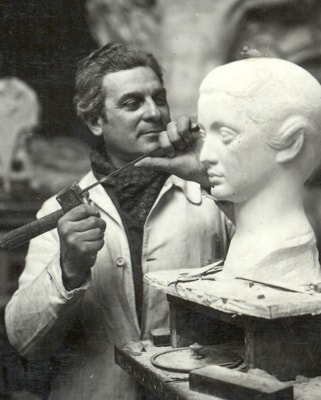
Paul BELMONDO
Son of a Piedmontese blacksmith, Paul Belmondo was born in Algiers in 1898, where he took his first lessons in drawing, sculpture and architecture at the Ecole des Beaux-Arts. After the First World War, a travel grant enabled him to join Jean Boucher's studio in Paris, but it was with the Algiers sculptor Béguet, a pupil of François Rude, that his vocation as a sculptor was revealed. Based in Montparnasse, he quickly made friends with Charles Despiau, becoming one of his most fervent disciples. Referring to Despiau, he said: "He talked to me about Rodin, who was his god". Paul Belmondo was perfectly in tune with the modernity of his time, inspired by Greek art, marked by the monumentality of Rude, and faithful to the humanism of Despiau. His career was marked by public commissions that highlighted his mastery of direct carving and monumental sculpture.
He left his mark on this art with the large bas-relief of La Ville d'Alger recevant les fruits du travail (The City of Algiers Receiving the Fruits of Labour) in 1935, La Danse (The Dance) created for the Palais de Chaillot in 1937, the Apollon (Apollo) in 1942, now housed in the Faculty of Science at Orsay, and the Baigneuse (Bather) for the fountain in Orléans in 1955. The quality of his work in this field allows him to be the chosen’ sculptor to copy Carpeaux's Danse in 1960, the original of which is now in the Musée d'Orsay.
He also excelled in a more intimate art, that of portraiture, portraits of family members such as his son Paul, his daughter Murielle and Madeleine Belmondo, as well as celebrities such as Maurice Genevoix. Recognised by his peers, he was appointed professor at the École nationale des Beaux-Arts in 1953. In 1958 he was awarded the Médaille d'Or des Artistes Français, and in 1960 he was elected to the Académie des Beaux-Arts.


